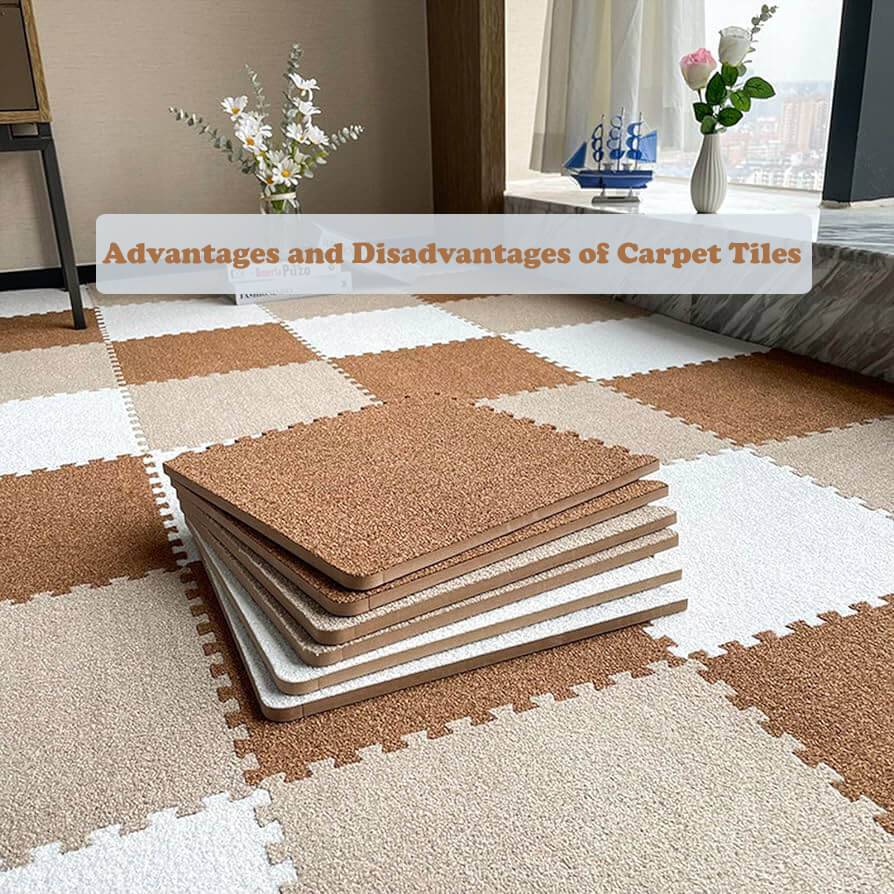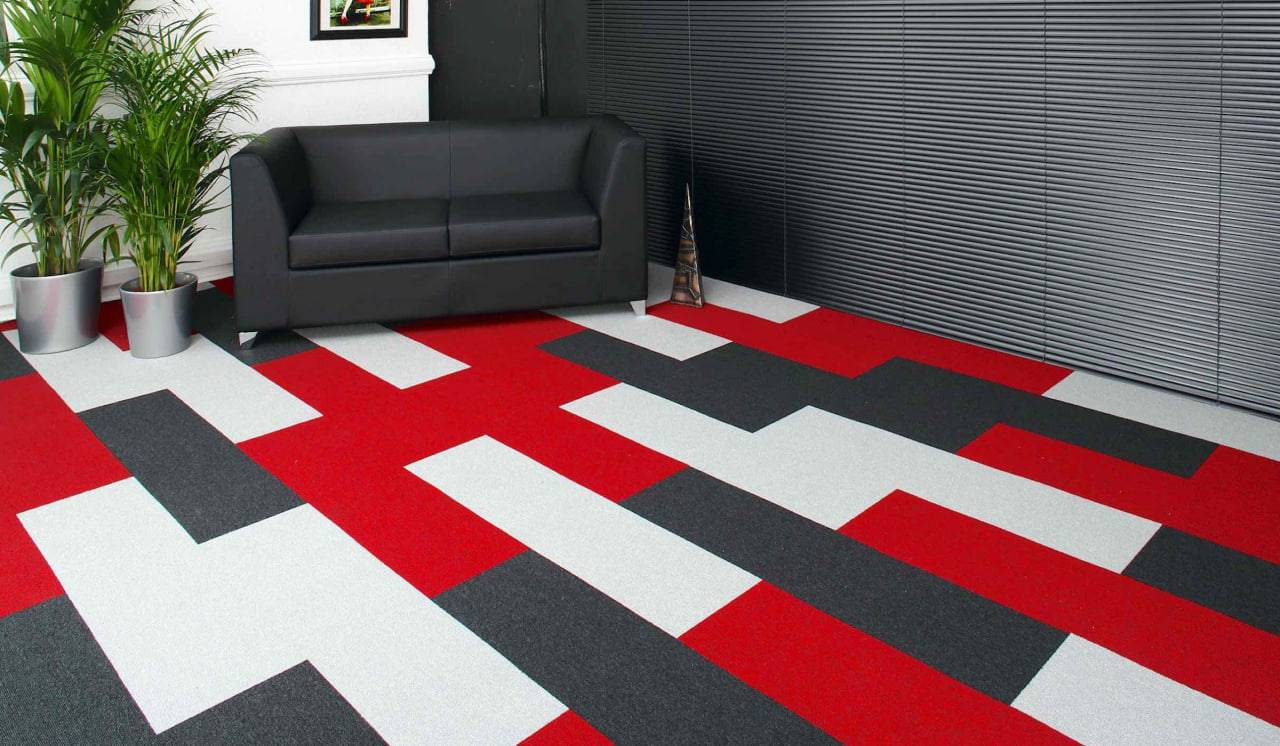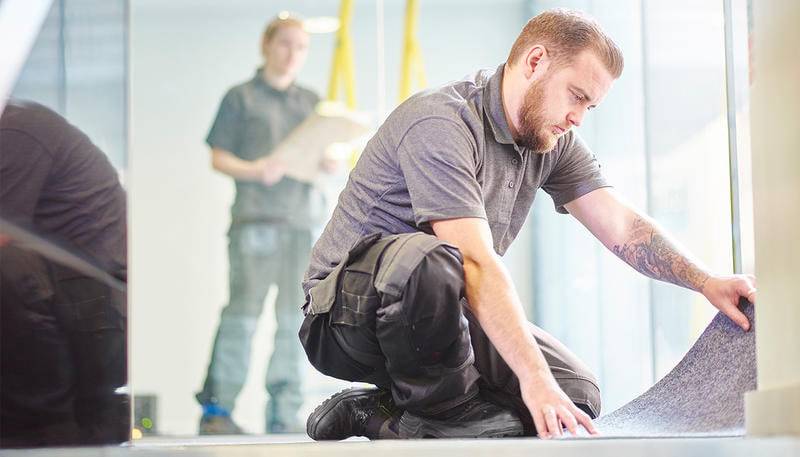For that touch of warmth, texture, and style in your commercial or living space, carpet offers a perfect solution. But when it comes to installation, there’s more than just the traditional wall-to-wall broadloom carpeting.
Carpet tiles, with their modular design, have become a popular choice, especially in high-traffic areas. But are they the right fit for your project? Let’s delve into the advantages and disadvantages of carpet tiles to help you decide.
Transform your space with Dex Flooring‘s easy-care carpet tiles. Shop now!
What Are Carpet Tiles?
What Are Carpet Tiles? Carpet tiles, also known as carpet squares, are individual tiles of carpet that interlock for easy installation. They typically consist of a layer of fibers tufted onto a primary backing, then further reinforced with a second layer.
Invented in the mid-20th century, carpet tiles were designed for DIY-friendly installation in homes. Today, while broadloom carpets remain popular for domestic use, carpet tiles have found their niche in commercial spaces. Their advantages – durability, easy maintenance, and efficiency – make them ideal choices for high-traffic areas like offices, schools, and industrial settings. But that’s not all! Carpet tiles also come in a wide variety of fun designs, allowing you to add a pop of personality to commercial spaces.
What Size Do Carpet Tiles Come In?
Beyond the Standard Square:
While 50×50 cm is the most popular size for carpet tiles, you’ll find them in a variety of shapes and dimensions to suit your needs. Craving a unique look? Consider non-square options, though these might be pricier and require more planning during installation (but no worries, professional installers can handle it!).
What Carpet Tile Styles Are Available?
From Classic to Cutting-Edge:
Remember the bold colors and patterns that made carpet tiles a hit in the 60s and 70s? Modern technology has brought back that design enthusiasm with even more vibrant options.
The traditional “boxy” look, where patterns seamlessly flow across tiles, remains a favorite. However, geometric shapes are gaining popularity in office spaces, creating a more dynamic aesthetic.
Carpet tiles come in a variety of materials, each with its own advantages. Nylon, known for its durability and recyclability, is a popular choice. You’ll also find options like wool, polypropylene, and even recycled polyester (PET).
Carpet Tiles: The All-Star Flooring Option
Effortless Installation:
One of the biggest perks of carpet tiles? Convenience! Their modular design makes them easy to store, transport, and handle, even in smaller quantities. Professional installers love them too, as they’re a breeze to put down, minimizing disruption and keeping your space operational in no time.
Versatility Reigns Supreme:
Carpet tiles are true chameleons. For modern offices with intricate cable networks, carpet tiles are lifesavers. They can be easily cut to access hidden utilities without damaging the entire floor.
Cost-Conscious Choice:
The installation speed, thanks to their modularity, also brings significant savings. Professional installers can get the job done much faster compared to wall-to-wall carpeting, reducing downtime and disruption in businesses.
Built to Last:
Renowned for their durability, carpet tiles are champions in high-traffic areas. Carpet tiles can be customized to your needs. By adjusting the fiber type, pile weight, and backing, you can achieve the desired look, feel, and performance for your space.
Effortless Maintenance:
Keeping your carpet tiles looking their best is a breeze. Regular vacuuming does the trick, thanks to the low pile design that minimizes dirt accumulation. And if a spill happens or an area gets worn, no worries! Simply remove and replace the individual tile, just like you did during installation.
Sustainable Champion:
Minimize waste from the get-go! Unlike wall-to-wall carpeting, carpet tiles are ordered to perfectly fit your space, reducing leftover materials. This benefit extends to the long run as well. If a section needs replacing, you only need to swap out those specific tiles, not the entire floor. Tiles that don’t suit your current needs in terms of color, design, or wear can be refurbished and used in other settings, like social housing.
Carpet Tiles: Considering the Downsides
While carpet tiles offer many advantages, it’s important to be aware of some potential drawbacks that stem from their modular design:
- Visible Seams: Even with perfect installation, carpet tiles might not achieve the seamless look of broadloom carpeting. However, some tile designs excel at mimicking a broadloom appearance.
- Fraying and Loose Fibers: Due to the increased number of seams, there’s a higher chance of fraying or loose fibers along the edges. The good news is this is usually a minor issue that can be addressed during or after installation.
Installation Considerations:
Following manufacturer recommendations and relevant standards is essential:
- Acclimatization: Improper acclimatization can lead to tiles shifting after installation, causing unsightly gaps or uneven surfaces. This risk is higher during periods of fluctuating temperatures.
- Adhesive Selection: Different tiles require specific adhesives for optimal stability. Be sure to follow the manufacturer’s instructions on adhesive type and application.
Luxury Perception:
Carpet tiles have sometimes been perceived as less luxurious underfoot compared to broadloom carpets with padding. However, this is no longer necessarily true. Many carpet tiles now come with built-in cushioned backings that enhance comfort, insulation, and reduce fatigue.
So, Should You Buy Carpet Tiles?
The decision depends on your priorities. Here’s a quick recap of the key reasons to choose carpet tiles:
- Faster Installation: Minimize downtime with a quicker installation process.
- Easier Handling: The modular format simplifies storage, transport, and handling.
- Cost Savings: Potential cost savings can arise from faster installation and ease of use.
- Easy Maintenance: Regular vacuuming and the ability to replace individual tiles make maintenance a breeze.
- Design Flexibility: Add personality and color to your space with a variety of carpet tile designs.
Conclusion
Carpet tiles offer a compelling alternative to traditional broadloom carpeting. Their modular design brings a host of benefits, from faster installation and easier maintenance to superior versatility and potential cost savings. However, it’s important to consider the potential drawbacks, such as the visibility of seams and the importance of proper installation.
Ultimately, the best choice for your space depends on your specific needs and priorities. Weigh the pros and cons carefully to determine if carpet tiles are the perfect fit for your project.
FAQs
Q: Are carpet tiles still in style?
Absolutely! Carpet tiles have seen a resurgence in popularity in recent years, especially in commercial spaces. The wide variety of designs, colors, and textures available allows for modern and stylish flooring solutions.
Q: What are some upcoming trends in carpet tiles?
- Sustainable materials: Eco-friendly options made from recycled materials are becoming increasingly popular.
- Bold patterns and textures: Look for innovative designs that add personality and visual interest to a space.
- Luxury underfoot: Carpet tiles with built-in cushioning offer the perfect blend of practicality and comfort.
- Customizable options: Mix and match different colors and textures to create unique and personalized flooring.
Q: Are carpet tiles difficult to maintain?
No, carpet tiles are generally quite easy to maintain. Regular vacuuming is usually sufficient to keep them looking their best. The modular format also allows for the easy replacement of individual tiles if they become damaged or stained.



